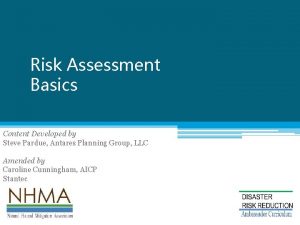Earthquake Mitigation I Techniques for Reducing Earthquake Hazard

- Slides: 1

Earthquake Mitigation I: Techniques for Reducing Earthquake Hazard “Earthquake Hazards and Risk Mitigation in Western Washington and Oregon” Keoni Wong, ES 473 Environmental Geology, Spring 2009 Abstract Earthquakes are unequivocal. Emergency planning and implementing strategies to prevent loss of life and property is the only real way to be ready for when an earthquake hits. Identifying hazardprone areas, preparing development plans, reinforcing failure-prone buildings, and public outreach are some techniques used to reduce earthquake hazards and potentially save lives. Once these protocols are established, and risk models are developed, planners and decisionmakers can use this information to guide modification of building codes to make sure that all roads, offices, residential areas are modernized and ready to withstand earthquake motion. These hazard-mitigation techniques are necessary to reduce the risk to human life and property, potentially saving regional governments billions of dollars in losses should an earthquake ever occur. This paper focuses on earthquake mitigation techniques that are currently employed in the Pacific Northwest. Introduction Techniques for Buildings Studies and overall knowledge of Earthquake hazards in Oregon has increased significantly since the 1980 s. Planning and mitigation efforts have also increased in terms of earthquake response. Buildings are being made stronger and techniques were developed to lower property damage and keep the public aware and safe. Predicting earthquakes and potential damage to homes is difficult due to variables such as magnitude and distance of epicenter from populations. Being prepared and knowing earthquake hazards can ultimately help in reducing its destruction when the time arrives. Fig. 1 (Fig. 1) Yellow Asterisks show origins of earthquakes underground along the Cascadia seduction zone. Cities lying just above the convergent plate boundary should have Earthquake hazard plans ready. Fig. 3 § Strengthen, Convert, or Remove unsafe buildings in the town. § Masonry walls need to be reinforced to withstand shaking and avoid collapse. § Owners can retrofit their buildings allowing it to be supported during an earthquake. § Secure non structural objects such as light fixtures to avoid injuries. (Fig. 3) Map showing the buildings in Oregon that have been assessed. Federal emergency management agency (FEMA) look for sites that are older, on unstable soil, and that may have negative seismic response. Involve the Public Conclusion Creating pre- and post-plans to mitigate the potential dangers in a hazardous situations can benefit an entire city. If community meetings are held making sure that everyone is aware of potential dangers, this allows for less panic and more organization if an earthquake should occur. Guide books or pamphlets are really helpful in spreading knowledge about earthquake hazards. Property will be damaged to some extent regardless of preparation during an earthquake. However, damages can be drastically reduced with proper building retrofits and stronger housing designs made to withstand shaking. Furthermore, human life is not lost due to the earthquakes itself, but from failure of buildings and non structural manmade objects. By knowing building foundations and studying hazard prone areas, geologists can use information to place new residences on sturdy ground. Communication and town meetings can address important emergency topics such as earthquake mitigation to make sure that everyone is on the same page. Earthquake hazard planning can play a major part in keeping people safe and aware when the earth begins to rumble and lives are on the line. Firefighters can also play an important role when dealing with schools by demonstrating proper drills for children to practice in case of an emergency situation. References Wang, Zhenming and Madin, Ian P. Relative Earthquake Hazards map. State of Oregon: Print. Contact Information Name: Keoni Wong Organization: ES 473 Email: kkwong 06@wou. edu (Fig. 2 A) Liquefaction can occur in areas like the Willamette valley causing building to sink or tilt. (Fig. 2 B) Ground shaking amplification cause roads and bridges to fail. § Study earth materials below building foundation to avoid potential liquefaction or subsidence. "Oregon Seismic Needs Assessment. " Oregon Department of Geology & Mineral Industries. 26 May 2009 <http: //www. wou. edu/las/physci/taylor/g 473/oregon_seismic_u pgrades. pdf>. http: //www. ce. washington. edu/~liquefaction/selectpiclique/nigat a 64/tiltedbuilding. jpg

